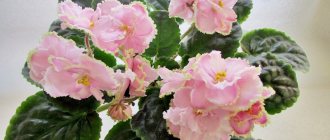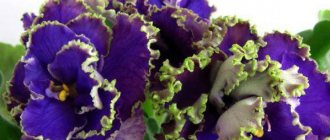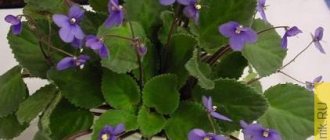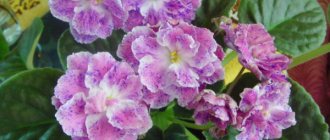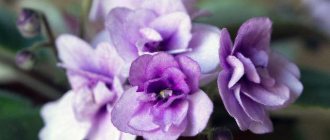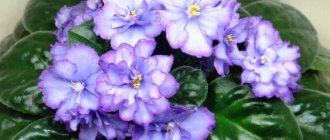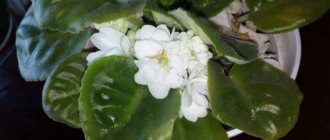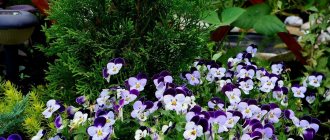Before purchasing a new specimen for the collection, most flower growers strive to become as familiar as possible with the information about this flower . In the case of Saintpaulias, it is important to take all factors into account.
Accurate knowledge of external data
will allow you to determine:
- Compliance with the variety;
- Or the attitude towards sports from this variety.
the subtleties of care to obtain a bush that:
- Develops correctly;
- Blooms in full force;
- And minimally susceptible to disease.
If we consider the RM-Faberge, then its external features require some special features in care and maintenance . Violation of which, at best, will lead to poor flowering, and at worst, to the death of the flower. In the article you will familiarize yourself with the photo and description of the variety.
Diseases and pests
If the violet is properly cared for, it rarely suffers from pests.
Diseases in these plants may be as follows.
- Fusarium. This is rotting of the root system, degradation and softening of the leaves. It is not possible to cure violet.
- Gray rot. Appears when the soil contains excess moisture. You should treat the flower with “Fundazol”, stop watering, sprinkle with rubbed charcoal and transplant into another container.
- Powdery mildew. Quite a dangerous disease. A fine white rash similar to talcum powder appears on the leaves. The violet should be treated with Topaz; there are also other fungicides.
- Mite. A pest that multiplies quickly and can spoil several violets at once. When it occurs, the leaves become covered with a yellowish coating and fall off. Such parasites appear as a result of a dry room and too high a temperature. You should make a solution of laundry soap and wipe the leaves and stems with it.
- Thrips. This is another dangerous pest that can attack the plant if there is not enough humidity in the room. In this case, Saintpaulia should be sprayed with insecticides “Aktellik”, “Inta-Vir”, “Fitoverm”, “Aktara”.
- Nematode. If you start a violet infected with a nematode, the plant will have to be eliminated (along with the soil and container). But if the violet has just “picked up” such an infection, then it should be treated with Fitoverm.
- Aphid. Treatment should begin as soon as the first signs of infection become noticeable. Signs of aphids: leaves turn yellow, gray, brown. It is treated with the same drugs as in case of tick infection.
7 photos
As preventive measures, the plant should be exposed to diffuse lighting (at least 12 hours daily), fed with various chemical compounds, and watered in a timely manner. In addition, be responsible for the propagation of violets and the composition of the soil. If there are any signs of illness, immediately isolate the plant by moving it to another room.
For information on the soil and volume of dishes for Saintpaulia, see the video below.
Growing and care
Saintpaulia “23-Faberge Smile” belongs to the group of tropical beauties with slow-moving vital processes , which guarantees the emergence of various nuances when collecting at home.
But correcting these features is quite easy, and the spectacular decorative appearance of a blooming violet overcomes all the difficulties that arise.
Features of cultivation
Violet is distinguished by the unusual shape of its flowers and the exquisite appearance of the bush, which is emphasized by the name of the variety.
But Saintpaulia, due to the structure of the rosette leaves, has a slow progression of all life processes and numerous unpleasant developmental nuances, especially at the stage of bush formation.
Perhaps that is why it is rarely found in flower growers’ collections.
Among the problems that accompany gardeners when growing “precious” Saintpaulia, the following can cause particular trouble:
- long leaf petioles interfere with the formation of an aligned rosette;
- minor violations of care regimens instantly thicken the center of the violet, which requires additional effort for manual editing;
- due to the wavy-pimpled structure, the leaves like to hug the flowerpot, bending down;
- a long stay of the violet in the budding phase is fraught with the expectation of complete dissolution and achievement of the highest decorative effect;
- Due to the weakness of the peduncles, violets are not able to form upright bouquets.
ATTENTION! From flowering to flowering, the violet gains strength and is able to increase the intensity of its color range and increase the number of formed and opened corollas.
The advantages of the variety include:
- very long preservation of freshness of flowers;
- multiple bud formation.
Growing up
Due to the inhibited passage of all vital processes, violet varieties take a long time to form the first flowers, that is, specimens mature later than Saintpaulias of other varieties.
Despite the willing and abundant formation of children on cuttings from leaves, it may take the violet about a year to go through the childhood period.
ADVICE! The moment the violet enters adulthood can be somewhat brought closer if, to obtain a young violet, you choose the method of planting a shoot from an adult specimen - the new bush has already been formed, all that remains is to grow the greenery and wait for the buds.
Reproduction
The variety is very easily propagated by rooting new bushes obtained by cuttings on a leaf.
To recreate Saintpaulia, flower growers also use the method of separating stepchildren that are ready for independent growth from the mother plant.
Propagation of violets by seeds is a lengthy, time-consuming, but absolutely ineffective process that threatens the complete loss of the variety.
In addition to the above-mentioned vegetative methods, it is possible to keep varietal characteristics unchanged during the violet rejuvenation procedure.
Temperature
high temperatures quite steadfastly, not forgetting to successfully form buds and bloom for a long time. This is its distinctive feature.
Cool conditions with a slight decrease in temperature characteristics also do not prevent the formation of flowers in incredible quantities. But for the bush to feel comfortable, it is imperative to protect specimens from sudden temperature changes and drafts.
Structure of peduncles
The varietal problem of Saintpaulia is considered to be insufficiently strong and too long peduncles , the qualitative structure of which does not change with age.
23-Faberge Smile has long and fragile peduncles.
This lack of peduncles makes it impossible to form lush bouquets from a large number of heavy flowers - from a certain moment the corollas begin to droop onto the leaves . And this harms the decorativeness of the plant.
Features of flowering
The typical lush bouquet of flowering expected by the variety occurs only at the initial phase of the process. Next, the emerging cute bouquet, due to the structural features of the peduncles, breaks up into parts that fall on the leaves of the rosette.
Flowering duration
Each blossoming corolla owes its long-lasting freshness and preservation of ideal decorativeness to the slow pace of development of the variety: the longer the bud blooms, the longer the period of youth of the corolla (up to one and a half months or more).
Description
The variety “EK-Bullfight Gold” stands out among others. It is an indoor plant with fairly large double star-shaped flowers of a rich “bloody” color. Depending on the nature of the lighting in the room, violet delights the eye with the most incredible shades. In bright light the flowers become bright scarlet, and in cloudy weather they turn brown and ruby.
A distinctive feature of this variety is year-round flowering. First, the rosette produces two or three low peduncles with a pair of buds on each. As soon as they begin to open, three more are formed. The result is a huge bouquet with flowers up to 8 cm in diameter.
The Saintpaulia rosette is flat and quite dense. With proper care and timely application of fertilizers, the plant reaches 30 cm in diameter. The leaf blades are large, slightly elongated, with a light wavy edge. Color – rich green.
"Bullfight" is a capricious plant. Most flower growers note the instability of its flowering, and doubleness often appears only on the third casting of peduncles, although there are cases when the rosette produced a double flower the first time. In addition, facts of alternation in the quality of the flowers themselves between individual blooms are recorded.
Another unpleasant feature of this Saintpaulia is the frequent yellowing of the leaves in the bottom row. Often the leaf plates located at the bottom of the rosette turn yellow and quickly die after the next bud opens. Moreover, this process does not depend in any way on the level of illumination, temperature conditions and irrigation features. This also does not mean that the plant has encountered a disease. That’s just the nature of Saintpaulia Bullfight.
Reviews
Oksana. “I bought a sheet of RM-Faberge. I was looking forward to the first flowers, and when it bloomed, I almost cried. In the first bloom, the flowers were small, simple, and white, with a small pink-purple spot. I gathered all my will into a fist and did not immediately throw it in the trash, I forced myself to wait for the second set of buds.
For the second bookmark, I increased the temperature. When it bloomed I beamed. A beautiful head of flowers with incredible color.”
With its beauty, violet attracts the attention of many gardeners.
Natalia. “For a long time I couldn’t get enough of the gift of Saintpaulia from RM-Faberge. This flower hat just beckoned me to it. But when it lived on my windowsill and bloomed again, there was no limit to disappointment. Very white, and without the normal fancy pattern. She began to search for information on the variety, and realized that she was simply cold.
Now she is in the warmest place in the house and delights with regular hats of incredible colors.”
Wild rock violet
Synonyms. Sand violet (V. arenaria).
The leaves are small, round, heart-shaped at the base and obtuse-angled at the top, hard, with long petioles, arranged alternately on the shoots. Long peduncles with medium-sized (12-17 mm long) flowers with a small spur emerge from the leaf axils.
Growing conditions. Under natural conditions it grows on dry slopes, fields, wastelands and light pine forests. Prefers sandy, rocky or calcareous soil.
Use: Rarely used in culture. Can be cultivated in natural style gardens, planted in clumps under a sparse canopy of trees, on dry edges, lawns and rock gardens.
Care
Violet "Angelica" is a fairly hardy plant that is not afraid of pests, but in order for development to occur normally, it is necessary to create normal conditions and do proper care
Here are the most important parameters that we recommend you pay attention to:
- degree of illumination;
- indoor humidity level;
- water temperature during irrigation;
- temperature during the day and at night.
Caring for flowers is not particularly difficult. The optimal temperature should be +18-23 degrees Celsius. To do proper watering, you should prepare appropriate trays; excess moisture accumulates in them for a short time and then evaporates. When watering, you need to monitor the water temperature, it should be at least +18 degrees. It is permissible to water the plant while the soil is drying.
For comprehensive lighting, it is recommended to rotate flower pots around their axis from time to time. Saintpaulia can bloom all year round; for this it is recommended to use artificial lighting. It is best to use fluorescent lamps or phytolamps. The flower does not tolerate direct sunlight and reacts extremely negatively to cold drafts, so take care of diffused light and warm space.
In the cold season, lighting should be present for 10 hours (this is the minimum), the room temperature should not fall below +15 degrees. In the winter months, the volume of watering is limited to twenty percent.
Combined soil is usually used, where there are:
- leaves;
- turf;
- needles;
- peat
The ratio is 3: 2: 1: 1, baking powder is also often added:
- perlite;
- vermiculite;
- sand.
Application of various fertilizers is permissible at least once every 2-3 weeks. Fertilizing should be done during the growing season. Thanks to proper feeding, the plant looks healthy and blooming. During the initial period of development, violets require nitrogen supplements; adult plants additionally require phosphorus and potassium.
Specialized stores sell special additives for Saintpaulia; when purchasing, it is recommended to consult with the seller. Fertilization is completed at the end of September - beginning of October, the plant must gain energy and rest in order to fully enter the winter period.
Replanting should be done every 12 months, while the root system should remain in a coma of earth. To successfully perform such an operation, you should additionally purchase large ceramic or plastic containers. Small holes must be drilled in all vessels, then full air exchange will be maintained.
Often, gardening associations and stores offer special pots for Saintpaulias. Such devices have special drainage holes through which excess moisture comes out.
The minimum size of a pot for violets can be about 65 mm in diameter, the second container should be 80-100 mm
It is important that the soil meets all requirements, otherwise the plant will not be able to fully develop. The soil acidity level should be between 5.6-6.6 pH
The soil sold in the store is labeled “Saintpaulia” or “violet”. Such a product requires improvement; certain additives should be added.
Dangerous diseases
Violet is a delicate flower that has low resistance to viral, fungal and infectious diseases. These problems appear on weak plants, the care of which does not comply with established rules.
High humidity levels and low ambient temperatures can lead to a number of diseases.
- Bacteriosis is a disease that can occur during the warm season. Signs are the presence of dark spots, darkening of the underside of the foliage, wilting of flowers and changes in the structure of the leaf blade. Methods of control: destruction of the plant.
- Powdery mildew is a fungal disease that can lead to plant death. Signs are the presence of a white coating on the surface of the leaves, which provokes the appearance of ulcers and roughness of the leaves. The causes are infection from soil, garden tools and diseased plants. Treatment is to remove infected leaves and treat the plant with special fungicides.
- Rust is a dangerous type of fungal disease that must be treated at the first sign of its appearance. Signs are the presence of brown spots on the surface of the leaf and yellow capsules with spores on the underside. Reasons: low light levels, weak immunity, plant infection. Treatment - removal of diseased leaf blades, isolation of the plant, treatment of the bush with fungicides.
- Root rot is a disease of the root system that prevents the formation of flowers. Signs: prolonged absence of peduncles, lethargy of leaves and petioles. Reasons: lack of drainage layer, poor quality of soil mixture, excessive watering, low soil temperature. Treatment is to remove damaged parts or completely destroy the plant, treat it with a fungicide and change the pot and soil.
When the first signs of the disease occur, a set of measures must be taken:
- removal of damaged parts of the plant;
- treating the flower with special chemicals;
- replacement of nutrient soil and flower pot.
It is strictly forbidden to fertilize the plant earlier than 30 days after its recovery. A weakened flower is not able to absorb nutrients, an excess of which can cause the death of the plant.
The following pests can harm the plant:
- spider mite;
- cyclamen mite;
- nematode;
- aphid;
- scale insects;
- fungus gnats.
When pests appear, the plant must be treated with special insecticides.
Beginning flower growers may encounter a number of other problems:
- wilting and drying of leaves;
- staining;
- rotting of the root system.
Causes of yellow and brown spots:
- sunburn;
- low or high air humidity;
- unbalanced watering with cold water;
- excessive application of nitrogenous fertilizers.
To learn how to properly water a violet, watch the video below.
Violet 23-Faberge Smile (Yan Zubo)
Who is author?
The unusual flower shape variety “23-Faberge Smile” was registered in the Saintpaulia register by a Moscow scientist with a PhD in biological sciences, Jan Zubo.
For some time, Jan was engaged in the selection of Uzambara violets as part of a family enterprise (with his mother, N.F. Andreeva).
Its spectacular line of pods contains a number of varietal standards and ampelous varieties.
The variety was introduced to flower growers in 2007.
Taxonomy of the variety
Subject to the scientific-hierarchical principles of taxonomic typology, the violet “23-Faberge Smile” belongs to the Saintpaulia genus (Gesnerieceae family), .
In terms of diametrical indicators, the specimens are directly related to the standard subspecies , and in terms of the structure of the corollas - to the fringed varieties.
Photo and description
Well preserving varietal characteristics, but developing at a much slower pace than violets of other varieties, the “precious” Saintpaulia, ready for flowering, has slightly sloppily arranged bushes , the numerical gradation does not exceed the standard indicators of the type classification.
In a correctly formed violet, the tiers of leaves fit quite tightly to each other, forming a lush volume without obvious gaps.
The variety is characterized by small leaf blades , resembling a wide oval outline with almost orthogonal roundings.
themselves have a clear extrusion of the venation , causing a quilted structure with voluminous, bubbly swellings of the surface, contours with a large wave, light notches along the edge and coloring with a shade of spring greenery.
The strong shine of the leaves and the thin, fluffy hairs on them give the rosette additional brightness.
IMPORTANT! The slow development of Saintpaulia also affects the flowering phase - the buds very gradually open their petals. But the half-open state of the flowers, which can last up to a month, does not harm the decorative effect of the violet, simultaneously increasing the lifespan of each corolla.
The violet prefers to bloom according to its own program:
- observing the lengthy procedure for blooming buds;
- creating a voluminous but disintegrating bouquet of flowers;
- changing the color scheme of the corollas as the buds open;
- long-lastingly maintaining the decorative effect of the corollas.
Medium-sized flowers of increased double filling in varietal specimens are formed due to the multiplicity of petals with edges of thick fringe and their curly configuration.
NOTABLE! The special charm of violets depends on the multi-colored range of corollas and the prevalence of different shades in individual flowering phases.
Buds and barely opening flowers are in most cases painted with greenish colors, and a fully blossomed flower has white petals with pinkish-crimson edging , ending with a fringe of tints of bronze, brown and green.
The greenish color on the frill is concentrated closer to the middle of the flower.
Violet does not form sports and is distinguished by persistent repeatability of the varietal range.
Diseases and pests
Violet Red tulip suffers from rot (brown and gray rot, powdery mildew, late blight) under the following conditions:
- Too high humidity;
- And low temperature;
- In a draft.
You need to be especially careful in winter - the pot can be very cold from the windowsill. You need to use a stand or remove the plant from the window altogether. Plants infected with late blight with brown spots on the leaves and rotting roots should be isolated from other Saintpaulias and destroyed as quickly as possible.
Gray or whitish spots are not as dangerous. Diseased areas are removed, and the rosette is treated with a fungicide, such as Fundazol.
New plants are not placed next to domestic ones, but kept separately for a month so as not to accidentally infect them.
- Late blight is characterized by brown spots on the leaves and rotting roots. The plant affected by it is completely eliminated, and the container is disinfected. Superphosphate is added for protection.
- For gray rot (gray spots on any part of the plant), the damaged parts are removed, and the plant is replanted and treated with a fungicide.
- Powdery mildew is identified by whitish marks on the leaves. To combat it, the drug Fundazol is used.
The flower can be attacked by pests - mites, aphids, thrips, scale insects, whiteflies, nematodes, false scale insects and other insects. Acaricides help against ticks, the drug Agravertin helps against scale insects, and thrips cannot tolerate the insecticide Aktara.
These violets get sick due to improper growth conditions. Diseases are easier to prevent than to treat.
Diseases and pests
When growing a plant as vulnerable to disease as the Poppy Poppy, you should be well aware of all the possible diseases that the plant can encounter. Most often, the plant suffers from several diseases.
- Powdery mildew is common not only among these violets, but also among many other plants. The disease is fungal and manifests itself as a white coating on the leaves. Often the culprit is too much moisture and too low a temperature. For treatment, drugs such as Topsin, Topaz or sulfur powder are usually used.
- Fusarium. In the same way as in the previous case, the disease fusarium is fungal. Its appearance is provoked by pots that are too large and sudden temperature changes. Leaves and roots rot and then disappear altogether. To treat a plant from fusarium, fungicides should be used, eliminating all diseased areas.
- Late blight. A plant affected by late blight becomes brown and gradually begins to lose leaves. The first step is to remove the flower from its pot and carefully examine it, identifying the affected areas. In case of severe damage, the plant must be disposed of, leaving the cutting behind.
- Gray rot. This disease is quite easy to distinguish from others - a gray coating forms in various parts of the plant. It is usually infected through the soil. Infected areas must be destroyed, and the remaining parts of the plant must be treated with fungicides.
However, you should not focus only on diseases, because parasites are another threat to the plant. It is worth considering the most common
- Spider mite. When it settles, the leaves begin to gradually turn yellow, and the growth of the flower noticeably slows down. Particularly attentive gardeners may notice a thin cobweb. To combat such a mite you will need a soap solution or chemicals. Spraying should be carried out no more than 3 times, maintaining an interval of 7–9 days.
- Thrips. In the presence of this pest, anthers and flowers are affected. The buds wither, losing all the pollen. The drug “Actellik” is ideal for treatment. It is recommended to spray 2-3 times with an interval of 1 week.
- Mealybug. Another extremely unpleasant pest, which can be detected by a white coating on the leaves and roots. In this case, a soap solution and a complete replacement of the soil are required.
For a review of the “Chic Poppy” violets, watch the video below.
Russian king of jewelers. Russian jeweler of kings
A jeweler by birth, a manager by vocation. Carl Faberge was born in St. Petersburg in 1846 among precious metals and precious stones. He inherited his father's jewelry production and raised the family business to unprecedented heights.
The Russified French of Faberge . Karl received a jewelry education in Germany, and an economics education in France, and went around the world. He studied the art of working with precious metals of the Venetians, the skills of Saxon stone-cutters and French enamellers. At home, Faberge worked for free as a restorer at the Imperial Hermitage. He cultivated his taste in the works of old masters.
From family business to international holding . At the age of 26, the jeweler took over his father’s business. While his colleagues were creating in the Renaissance, Rococo and Empire styles, Faberge moved into Art Nouveau. At exhibitions I looked closely at new trends, and at the same time at gifted jewelers. As a result, up to 500 workers gathered in numerous workshops, and each was headed by a bright talent.
Fateful opening days . In 1882, at the All-Russian Art and Industrial Exhibition in Moscow, Faberge products attracted the attention of royalty: Emperor Alexander III and his wife Maria Feodorovna. At the Nuremberg Exhibition of Fine Arts, copies of Scythian treasures received a gold medal, and their creator received the right to put the mark of a double-headed eagle on the products. At an exhibition in France, Faberge received the Order of the Legion of Honor.
Revolution in jewelry . From material cost to artistic value. “If the whole value of expensive things lies in just a lot of diamonds or pearls, then they interest me little,” said Faberge. The master even used steel and tin in works of art. And brooches made of Karelian birch, in which he interspersed diamonds, became fashionable thanks to Faberge.
"Faberge - the incomparable genius of our time" . Maria Fedorovna spoke so flatteringly about the master in a letter to her sister, Queen Alexandra of England. Faberge made the famous Easter eggs for the Empress, which she remembered from her Danish childhood. Egg shape, surprise inside, uniqueness. Three components are the main social intrigue of every Easter holiday in the imperial family.
“Lefty of St. Petersburg” or “singer of graceful dreams” . Among the pompous epithets, the jeweler himself preferred the capacious “supplier of the Highest Court.” And not only the Russian court. Swedish, Norwegian, Danish, Spanish, and English royal courts valued Faberge's works. The master made a decorative vase for Bismarck, a jade wreath for the tomb of the Swedish king Oscar II, and a jade Buddha for the court temple of Siam.
The Empress and the Maid . Availability. One of the principles of the Faberge jewelry house. The Ural, Altai and Trans-Baikal gems, which are no longer in demand in industrial quantities, were used. Pendants in the shape of Easter eggs cost no more than a pound of good tea. Separate workshops produced photo frames, perfume bottles, brooches, orders - to suit any budget.
Precious joke . Not only refined taste, but also a sense of humor distinguished the court jeweler. A unique still life from 1905 is a humorous “gentleman’s set”: a brick, fried eggs, a faceted glass with a strong drink, and a snack. Brick - from jasper; yolk - from amber; newspaper, fish, flies - made of silver; the glass and contents are made of quartz. The prosaic plot turned into a work of art.
“There is no point in living like this,” said Carl Faberge after the 1917 revolution. The Soviet government sold most of the unique collection to Great Britain and the USA. The court jeweler did not come to the court of the new government and left with his family for Switzerland. But I couldn’t do what I loved in Europe. Carl Gustavovich Fabergé died in 1920 and was buried in Cannes.
Return to Russia . The Faberge Museum opened in the Shuvalov Palace in St. Petersburg in 2013. The main value of the museum exhibition is nine imperial Easter eggs created by the master for the last two Russian emperors. The collection also includes many elegant items that were sold a hundred years ago in Faberge stores in St. Petersburg on Bolshaya Morskaya, in Moscow on Kuznetsky Most, in Odessa on Deribasovskaya, in Kiev on Khreshchatyk and in London on Bond Street. The very things that changed the taste of an entire era.
Caring for young violets
After the babies have been seated in cups and the stepchildren have taken root, they still need care. During this period, young plants are more sensitive to light - they love diffused light, preferring northern and north-eastern windows.
Priming
Grown-up children, 4-5 cm in diameter with two or three pairs of leaves, are transplanted into a special earthen mixture. As with cuttings, it should be light and poor in nutrients.
An example would be the composition: nutrient soil for violets mixed with high-moor peat (poor in nutrients) and filler (perlite, foam balls, etc.) in a ratio of 1:2:1.
The soil for violet babies should be quite loose.
As the children grow, they are transplanted into larger containers with a diameter of 7-8 cm, and then 9-10 cm.
Features of watering
The watering regime largely depends on the violet growing conditions. The flower should not be over-dried or over-watered:
- It is recommended to water only after the top layer of the substrate has completely dried;
- It is preferable to water the flower through a tray. The top watering is carried out carefully, trying not to get on the leaves;
- Stagnation of water in the pan is not allowed after 30 minutes. After watering, excess liquid is drained.
In conditions of low temperature, the amount of watering is reduced.
Useful tips! You can tell whether the soil is wet or dry by the weight of the pot - hold it in your hand before and after watering to feel the difference.
